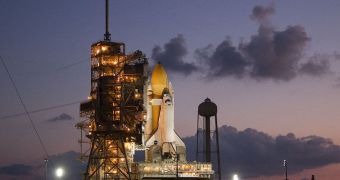The space shuttle Discovery has been standing at its launch pad in Florida since September 20, aiming for a launch last month. But delays have pushed the mission well into next year, and so engineers at NASA have taken the logical next step, which is to return the orbiter to its hangar.
The decision was made yesterday, December 13, as NASA mission managers were investigating how to continue with the repairs that Discovery needs to get before it can be allowed to fly to space.
As such, the officials decided to take it away from the Launch Pad 39A at the Kennedy Space Center (KSC), where it remained docked for nearly two months, and send it back to hangar for processing, inspections and repairs.
The rollback maneuver will take place no earlier than December 22, officials at NASA say on their respective Twitter pages. The trip will begin after a tanking test is carried out with the shuttle's external fuel tank.
Originally, the test was scheduled to take place yesterday, but cold weather has pushed the verification back for another three days, until at least December 17. The shuttle will be transported back to the KSC several days after that.
The tanking test delay was brought on by the fact that the sensors used to collect the required data could not be affixed to the sides of the orbiter's massive external fuel tank.
The devices are designed in such a way that they cannot connect to the EFT when temperatures are too low. Around the KSC, temperatures are nowhere near the levels they should theoretically have.
Given that the shuttle is now scheduled to launch in mid-February, NASA officials hope to have it back at the launch pad by mid-January. However, at this point, there is way too much uncertainty about the work that needs to be done on it to allow for establishing a clear timeline.
Building a new EFT is not a feasible option, given that the Michoud Assembly Plant, the facility that constructed the structures, has finished production this year, and its employees largely laid off.
Moreover, it would take more than two years to construct a new fuel tank, so this is not really an option. But experts say that it's still too early to tell whether that will be needed. NASA engineers will assess the work that needs to be done.
Discovery was initially set to fly in early November, and was headed for the International Space Station (ISS). It is carrying a multipurpose logistics module, as well as the Robonaut 2, a collaborative project between NASA and General Motors.
The human-like robot was designed to assists ISS astronauts, and eventually spacewalkers conducting extra-vehicular activities (EVA) on the exterior of the station, Universe Today reports.

 14 DAY TRIAL //
14 DAY TRIAL //